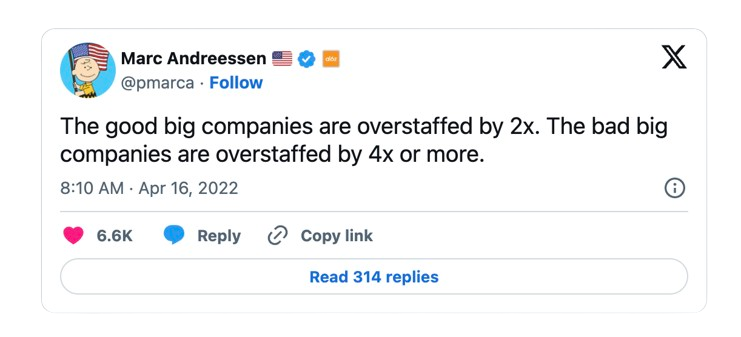Too many startups fall into the trap of hiring too many people too soon. Some do it to show growth after fundraising, others do it because they think more people will get them closer to product market fit (PMF). In almost all cases that I know of, this is not true. The hiring process, apart from distracting you from building a product people love, doesn’t stop once you’ve made the hire. Yet, a lot of founders erroneously get into the mindset that if they “scale a team and manage people” it means something has to be working.
I always love telling people the WhatsApp example. Back in 2013, before selling to Facebook, WhatsApp had 35 engineers and 400M MAUs. Two years later in 2015, while its team only grew to 50, MAUs skyrocketed to 900M. Goes to show how not bloating a team if things aren’t breaking is a good idea. Scaling should make things more efficient, not add complexity.
That’s not really a controversial opinion nowadays, though. The past two years have shown us that companies CAN work with fewer people. Sure, it hasn’t been long enough to be able to say whether they’re more successful with leaner teams, but none of them have shut down/failed because they didn’t have enough people. That’s almost never why startups fail. What happens instead is they start hiring for roles they don’t have an immediate need for and spend money on looking like a real company, rather than being one. Not to mention having to go through painful layoffs.

Hiring is not bad. Hiring is great when you do it with intention and know that putting more manpower behind a hypothesis you believe in will help you move along faster.
This is not a story to convince you that aggressively hiring isn’t the solution to your startup woes, I trust that most of our readers know that. It is, however, a look into our philosophy behind hiring exceptional people at CommandBar.
Obviously biased, but it didn’t take me long after joining to realize it’s not very common to have such a strong, capable, and highly efficient team in a series A startup. So I decided to pick James’ (self-declared big framework guy) brain to find out what frameworks he’s used to grow the team.
Before we open source our algorithm, take a trip down memory lane with me and see how the team structure evolved since a little over three years ago when CommandBar was born.
Pre-seed
This was during the YC batch, in the summer of 2020 and it was just the three CommandBar co-founders. Unless you’re in a later stage than most companies in the batch or have an obvious opportunity for growth, there is no good enough reason to bring in too many folks before you start feeling PMF. If you and your co-founders can build and sell, you’re good for now.
Seed
This is when CommandBar’s first hire happened. One person in the first 12 months. It’s very likely that your first non-founder hire will need to be a generalist. In these early days, priorities change, and they change quickly. You want someone who gets their hands dirty and is willing to switch lanes when needed. For us, that was Lucas. He wrote a great story about his experience as a generalist that I urge anyone wanting to be an early hire or needing to hire for their first few roles to read.
Besides Lucas, we’d hire contractors to supplement any workstreams we weren’t 100% convinced we’d want to double down on just yet or that we knew were just temporary.
Our philosophy behind not hiring much in the first year was that we wanted to feel PMF first. We didn’t want to hire an entire team to build company A and then decide to pivot to building company B. Looking back, this might’ve been a little too lean, and hiring a couple of engineers excited to join a seed-stage company could’ve been beneficial. The key, in hindsight, would have been to pitch people on joining a voyage to PMF rather than a specific idea. “We’re a small team with funding that’s currently building X. We’re really excited about it, but there’s a good catch we need to pivot to a different idea to achieve of our vision of building products to make software easier to use.” It turned out we didn’t pivot, but we’ve heard a gazillion stories of founders who hire early-stage employees who are really excited about the initial direction, and then become demoralized when the company has to pivot because it feels like they’re on a sinking ship.
Before raising our series A, we brought on 3 more people as PMF was starting to feel stronger and stronger and we felt like the odds of a meaningful pivot were low.
Series A
Series A is when we had a clear idea of what worked, what didn’t, and where we wanted to take the product, so we grew the team to 15 people.
If you're interested in optimizing your hiring process further, you might find this article on Recruitment Automation insightful. It explores strategies for efficient hiring and how AI-based recruitment automation tools can streamline the hiring process.
Fast forward to today, where we’ve got a team of about 40 people, which is probably ~50% of the size we could be given our financial situation and traction. Here’s how we make decisions about when to hire.
Our algorithm for hiring
There are two conditions that push us to grow headcount.
- When something is breaking
This is fairly easy to spot in functions that scale with size. Too many leads? Grow sales team. Too many customers? Grow support team.
Harder to tell with others, like engineering or marketing. This means you need two things to happen: (1) as a founder, have the ability to recognize when someone is dropping balls or becoming the bottleneck because they’re overworked and (2) guide employees to recognize this in themselves and others. Failure mode is not doing this consistently and ending up running a sweatshop where everyone feels burnt out.
- When we aren’t seizing an opportunity
Any strong beliefs that don’t have a clear owner/group of people to focus on fit here. Obvious improvements / low-hanging fruit that we believe will have a high expected value (i.e. not being able to pursue a new content idea that we have a good distribution strategy for).
Like the first condition in this algorithm, we make the team aware of this philosophy so they’re able to spot these opportunities and make the case for why we need to invest in them.
How not to hire
Don’t obsess over what competitors or other companies at similar stages are doing. Just because company X has a team of 10 product managers doesn’t mean they’re efficient. In my humble opinion, that’s a big 🚩but that’s a different story.
Instead…
- Do zero-based budgeting based on the minimum number of people that satisfy the algorithm. Targeting a burn number and saying “I want to burn $5M a year, that gives me a budget for X more hires on team Y” is a recipe for disaster.
- Unlock hiring with revenue. Hire a minimal team, and fix burn at whatever that costs, e.g. $100k/mo. As you add revenue, add hires to fix your burn (if you add $8.3k/mo of new revenue, you can afford to hire a new person who costs $100k). Always keep the algorithm in mind though. Just because you can afford to hire someone new, doesn’t mean you should/need to.
Who you should hire
Don’t settle for mediocre. It’s the one guaranteed way for your company to become bloated. Many founders try to hide this by hiring more people to make up for the original hire. It’s much better to part ways with them and find someone who’s closer to your expectations (learn to be realistic!) by using the knowledge you now have from the experience with the first person.
The more time I spend in startups, the more I realize there’s a specific type of person who succeeds in early-stage companies. Sarah Tavel calls them mitochondria. The way she describes them is as having a ”different DNA – they act more like founders than employees. They pour their passion into the company because they believe in its mission, and it is how they operate. They add value to the company beyond their job description and responsibilities. They ask and do what is best for the company.”
Look for highly self-motivated individuals, those who don’t need to wait around to be told what to do. Sure, your team won’t always be 100% mitochondria, but not having people who deeply care about their work in those first few stages of a company will only drain and frustrate you as a founder.
Hire exceptional people. If it won’t take your runway to a dangerous place, hire those on your “top 10 people I want to work with in my career” list. You’re much better off betting on quality over quantity in the early days.















